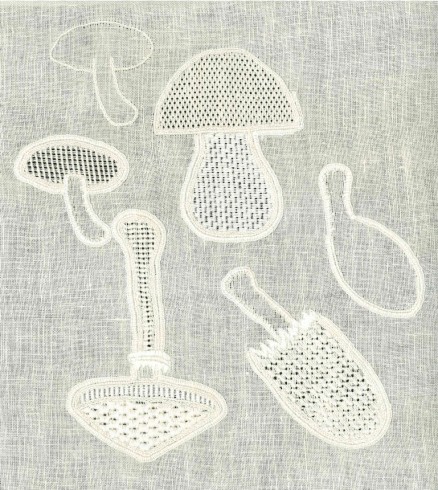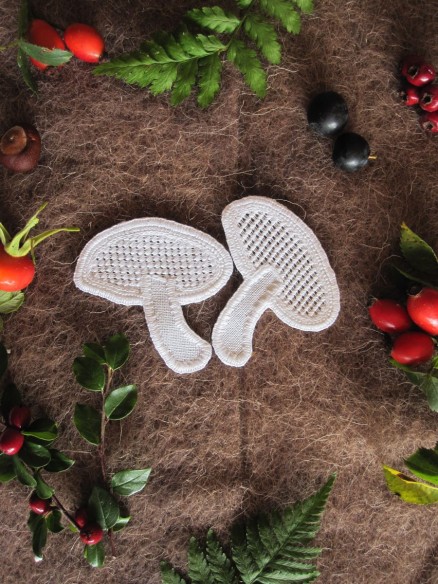Currently, our forests are full of magnificent – edible and inedible – mushrooms. Nature provides a treasure trove of different models for me to draw.

So, for September, I have chosen mushrooms.
 First, the line drawing has to be transferred onto paper using an iron transfer pencil and then transferred to the linen. Because the pieces are cut out later and to not waste linen, the motifs can be placed on the linen close together and randomly. Some motifs will be placed on the straight of grain and others placed on the diagonal – depending on the intended filling pattern.
First, the line drawing has to be transferred onto paper using an iron transfer pencil and then transferred to the linen. Because the pieces are cut out later and to not waste linen, the motifs can be placed on the linen close together and randomly. Some motifs will be placed on the straight of grain and others placed on the diagonal – depending on the intended filling pattern.
 On Weddigen linen, 13.5/cm thread count, Coral Knot stitches are worked along some lines using Coton à broder No. 16. All sections of a motif that will get a filling pattern later, are outlined with Coral Knot stitches.
On Weddigen linen, 13.5/cm thread count, Coral Knot stitches are worked along some lines using Coton à broder No. 16. All sections of a motif that will get a filling pattern later, are outlined with Coral Knot stitches.
 Using Coton à broder No. 20 Chain stitches are worked a small distance outside the Coral Knot stitches. The Chain stitches are covered with densely worked Blanket stitches. Because the stems of the mushrooms are often very small, they are not filled with patterns; outline the stems with Chain stitches and cover them with Blanket stitches. Around the stems, the legs of the Blanket stitches should be differing lengths.
Using Coton à broder No. 20 Chain stitches are worked a small distance outside the Coral Knot stitches. The Chain stitches are covered with densely worked Blanket stitches. Because the stems of the mushrooms are often very small, they are not filled with patterns; outline the stems with Chain stitches and cover them with Blanket stitches. Around the stems, the legs of the Blanket stitches should be differing lengths.
 Using Coton à broder No. 30 Chain stitches are worked directly inside the Coral Knot stitches.
Using Coton à broder No. 30 Chain stitches are worked directly inside the Coral Knot stitches.
In the mushroom above, the sections of the mushroom were filled with matching patterns – see Limetrosen 1, Basic Principles of Schwalm Whitework, Wickelstiche.
 Some parts of the motif, such as the frayed bottom edge, are worked with Satin stitches.
Some parts of the motif, such as the frayed bottom edge, are worked with Satin stitches.
After finishing, the embroidered pieces were washed (boiled), starched and ironed. Then, the mushrooms were cut. If needed, such closely trimmed embroidery can be washed and ironed – quick and easy – at any time, but never spun in a washing machine!
 Such mushrooms are nice to arrange – in groups or as a single specimen.
Such mushrooms are nice to arrange – in groups or as a single specimen.
As already mentioned in a previous article, all these small projects are only the precursors of Schwalm whitework.









Wunderschöne Arbeiten, ich bin total begeistert.
Ich arbeite gerade mal an verschiedenen Füllflächen für Herzen.
bis ich mich an soetwas wagen kann, dauert es noch.
vielen Dank fürs Teilhaben lassen.
Schönes Wochenende,
martina
Hallo Martina,
danke für den Kommentar. Wenn man erst einmal die Grundlagen für die Schwälmer Weißstickerei beherrscht – und das ist gar nicht s o schwierig, dann kann man mit dieser Technik wunderbar und fast grenzenlos gestalten. Das macht die Stickerei so faszinierend!
Beste Grüße
Luzine
Hallo Luzine,
die Pilze sind ja klasse. Tolle Stickarbeit.
Gruß
Anja